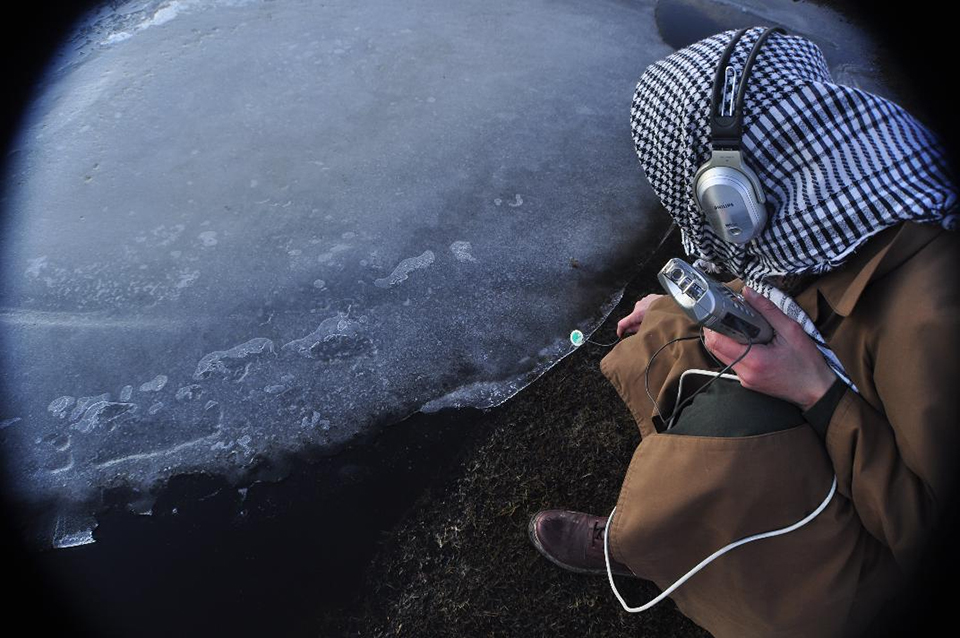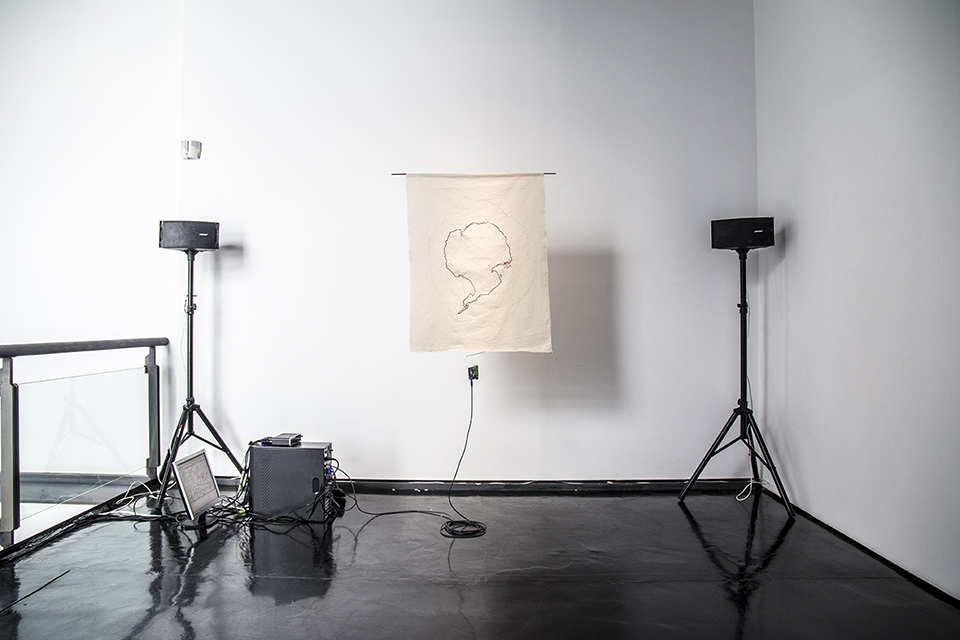Between the Imperceptible and the Sublime: Sound Ecology in the Chilean Antarctica
Alejandra Pérez Núñez’s work is based on a decolonial methodological perspective: she uses sound as a device to critically investigate that which is imperceptible to the eye and hidden in contemporary capitalist narratives. In recent years she has focused her study on the Chilean Antarctica. Her experimental listening processes reflect the complex, stratified sediment of political processes that appropriate and exploit the continent. Her research focuses predominantly on material developments dating from the Cold War era that were influenced by colonial expeditions from the beginning of the twentieth century.
The artist’s approach questions the epistemological framework construed by Europeans in recent decades that pictures the Antarctic as a clichéd exotic continent, a place of discovery; the continent is still considered an “external” space that can be forcefully conquered and colonized by Western enterprises. Within this context, listening reveals what would otherwise be imperceptible. It materially evidences a hidden strata, conveying a sort of blackout of invisibility similar to its opposite phenomenon, namely the white-out, the Antarctic glare. As a result, the continent’s exploitation and appropriation that have led to global geopolitical conflicts, its deposits, its riches hidden from the phenomenological experience are revealed in an ontological sense. The work emphasizes traces of the Antarctic’s representation subsumed into its subsoil, in Terranova Bay’s isotopes and other underground places hidden from view, infiltrated by nuclear and military activity since 1996. The sonorous narration of this space, an invisible eremos chora, a solitary and boundless place, reveals a clandestine process that is fed by different centers of political, military, and scientific power. In this isolated continent, the imperceptible becomes sublime, transcending every attempt to reduce its experience of it to a phenomenological point of view, conveying the impossibility of understanding its totality through the human senses. The artist herself writes:
The imperceptible in Antarctica is defined by the limitation of the human senses, even before the geophysical characteristics of the continent. The sublime refers to what lies beyond our capacity to understand in the phenomenological sphere and, in any case, there are imperceptible aspects referred to Antarctica as the largest continent on Earth, immensely depopulated and still to be exploited. This imperceptible alludes to geopolitical configurations, where the imperceptibility produced is ontological, relative to the presence of the national states that demand, or rather renounce to demand sovereignty over Antarctic areas in the Antarctic Treaty System. (Pérez Núñez 2017: 28)
Antarctica 1961-1996 (2009-2017), one of several sonic works within this research project, was exhibited as part of the Chilean sound art group show Otros sonidos, otros paisajes at the MACRO museum, Rome, between May and June 2017.[9] The piece, a quadraphonic audiovisual installation, is composed of a conductor antenna cable placed on a square-shaped canvas connected to a theremin sensor that modulates sounds via software (PureData).
Alejandra Pérez Núñez's Antarctica 1961-1996 (2009-2017). Audiovisual installation at MACRO Museum, Rome, 2017 (photo Leandro Pisano)
Entirely realized with open-source hardware/software technologies, the work is based on a sound mapping of the Antarctic peninsula, made by the artist in 2009. It allows participants to interact with field recordings captured at very low frequencies and to excavate the landscape through listening.[10] Through questioning concepts of the sublime and the imperceptible, Pérez Núñez crosses disciplinary boundaries, analyzing hidden military operations and technological accidents in Antarctic ecosystems. The installation, which includes four loudspeakers arranged in the corners of a 4m2 room and a wall-mounted TV, characteristically converges different media and technologies: movement sensors that identify the spectator’s position generate the soundscape in which they move; a hand-sewn fabric map references Antarctica’s points of exploitation; and a video, which displays software data as still and moving images and as background noise, confuses the media narrative, representing entropy and alluding to an information blackout.
Weddell seal recordings from Antarctica as diffused in the installation at the MACRO museum exhibition, Rome
This sensory and meta-medial intersection that the artist develops throughout the course of her research and practice, realized in an epistemological sense through rigorous and coherent deconstruction, provides an ecological vision. Whilst contiguous with Timothy Morton’s Dark Ecology (2016), Pérez Núñez’s work presents a series of unsolvable puzzles. The impossibility of fully understanding the meaning of an era in which human history and geological time are so closely intersected suggests that we cannot discern that which is human from that which is not. Simultaneously, it communicates the urgency of a new ecological conscience in the face of climate change evidence and its consequences. Pérez Núñez abandons a contemplative approach; instead she takes an activist’s position. Her work resonates with respect for unintelligible and imperceptible natural environments, unmasking the opacity of political, economic, and knowledge mechanisms behind an entire continent’s exploitation. From a perspective based on sublime and imperceptible parameters, Pérez Núñez redefines the coexistence between mankind and the natural environment by recognizing the non-representational, indecipherable nature of what is post-human. Her work’s wider context overcomes rational and sensorial understanding. It is an echo, originating from south of the equator, refracting further southward along the sound lines of the Latin American Southern Hemisphere, resounding with the empty spaces and winds of the Antarctic peninsula, that opens the mind to new relationships, intersections, and reflections through sound and listening practices.


